Inglewood Historic Township Walk

Gold was first discovered at Inglewood in 1859 and the find sparked a flood of some 16,000 diggers to the area. By January 1860, a new field a few miles south was opened up and dubbed "New Inglewood" and this is the site of the present township.
By the mid-1860s, the population on the field was estimated at greater than 40,000, ranking Inglewood among the biggest rushes in Victoria's history.
Around the turn of the 20th century, gold production began to diminish and a new form of employment was sought.
The eucalyptus oil industry took hold when it was discovered that the leaves of the Blue Mallee, which grows abundantly around Inglewood, but in few other places, produced some of the best quality eucalyptus oil in the world. The district still produces the greater portion of Victoria's eucalyptus oil.
The town draws visitors keen to see its historic buildings and antiques shops, as well as the famed Eucy Distillery Museum.
Walk the blue plaque trail and discover the rich history of Inglewood, a town built on gold. There are 52 points of interest in the town. Download a map of the walk.
Inglewood Historic Township Walk Map

1. Town Hall
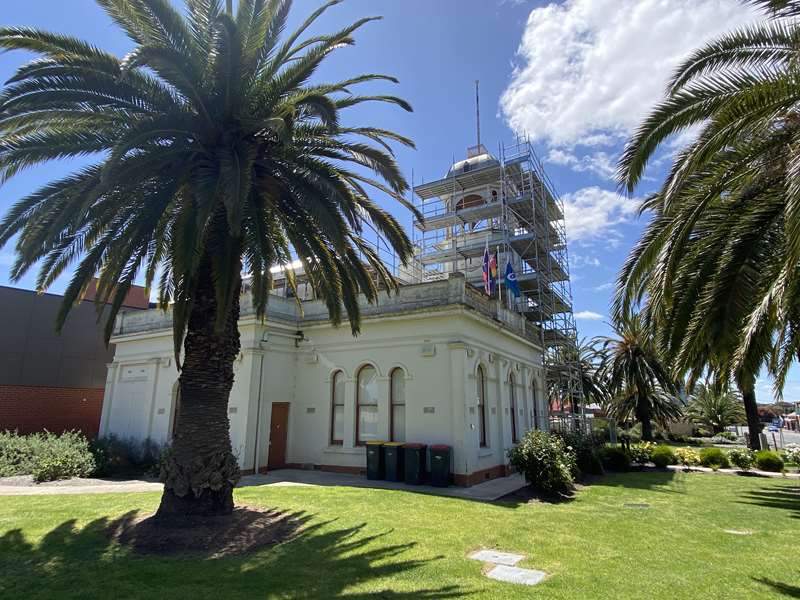
The Town Hall was built of locally made bricks in 1883 on the site of Inglewood's old Market Place. A new stage and strong room were added in 1891 with part of the roof replaced in 1892. Major alterations, including the construction of the balcony, staircase, supper-room and new stage curtain, took place in 1935. A major feature of the Town Hall is the large chiming clock. erected in 1954 in memory of those who died in the Second World War. The Town Hall was the administrative centre for the Borough of Inglewood until the town was annexed to the Shire of Korong in 1961.
2. Young Joe Tivey's House
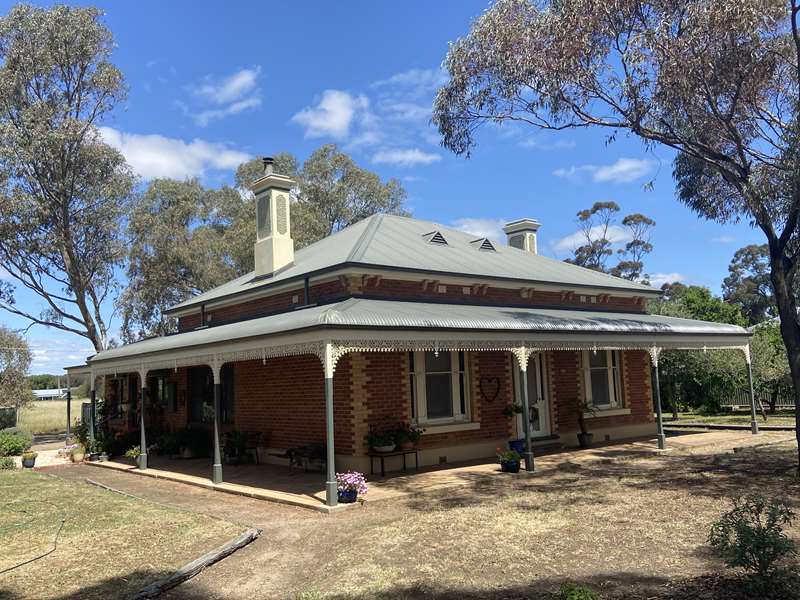
Joseph Arthur Tivey was a son of Joseph Tivey Senior who built the two-storey mansion further along Verdon Street. Joseph, the son, built this red brick house around 1900. He planted the tree on the footpath, a Eucalyptus citriodora, on 30th May 1914. On the death of his father, Joe and his brother Samuel operated the family grocery and merchandise store in Brooke Street. On Joe's death in 1931 the house passed onto his housekeeper Catherine Watts. This house reflects the Tivey desire to have a house in keeping with their respected standing in the town.
3. Charles J. Ansett
Charles Ansett and W.R. Ogden operated a cycle and engineering manufacturing business in Brooke Street around 1900, later becoming a motor garage until Charles enlisted in the First World War in 1916. The family lived in this weatherboard home and all five children were born in Inglewood. The fourth child was Reginald Ansett, born on February 13th 1909, who along with his siblings attended the Inglewood State School. Reginald went on to be the founder of Australia's largest domestic airline, Ansett Airlines, and was knighted in 1969. He passed away on 23rd December 1981.
4. Tivey 's House 'Nimmitabel'

After having purchased three allotments of land in 1879, Joseph Tivey contracted local builder W. Garland to build this fine home in 1881 at a cost of 1300 pounds. The house was built with thirteen rooms to accommodate the fourteen Tivey children and had a lavish and extensive garden. Joseph was the proprietor of a general merchandise and liquor store in Brooke Street. Following his death the house was occupied by his son, Sam Tivey.
5. Storm Lane Drain
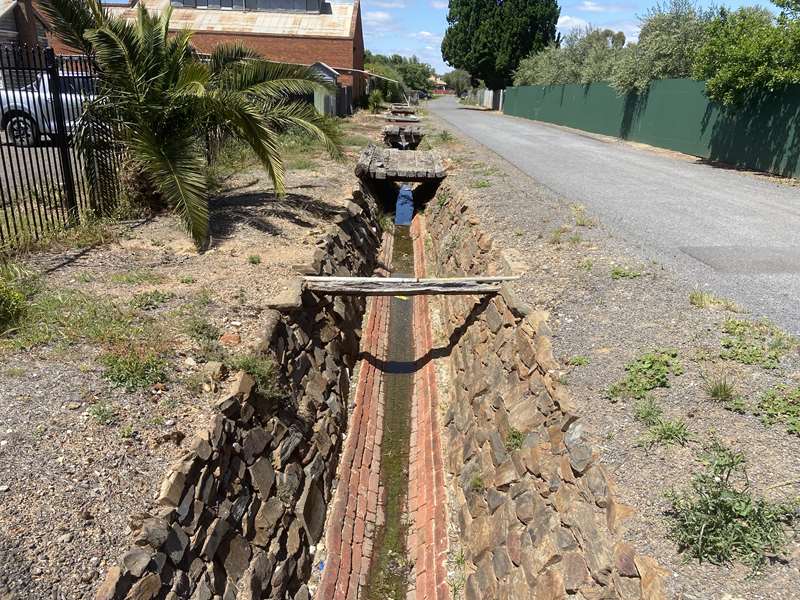
One of the first tasks of the newly formed Inglewood Borough Council in 1862 was to construct a stone rubble drain with a brick base in Storm Lane at a cost of 240 pounds.
The drain, along with others in the town, was an important part of Inglewood's drainage and sanitation. In those early times animal slaughtering occurred in the township backyards, hence offal and blood would flow freely into the drains. Nearly one hundred and fifty years later the town drains are important in moving storm water to the larger drain in Heales Street, built in 1867, and on to the Bul-a-Bul creek.
6. Porter's Drapery *
7. Southey's Newsagent *
8. E.E. Rochester
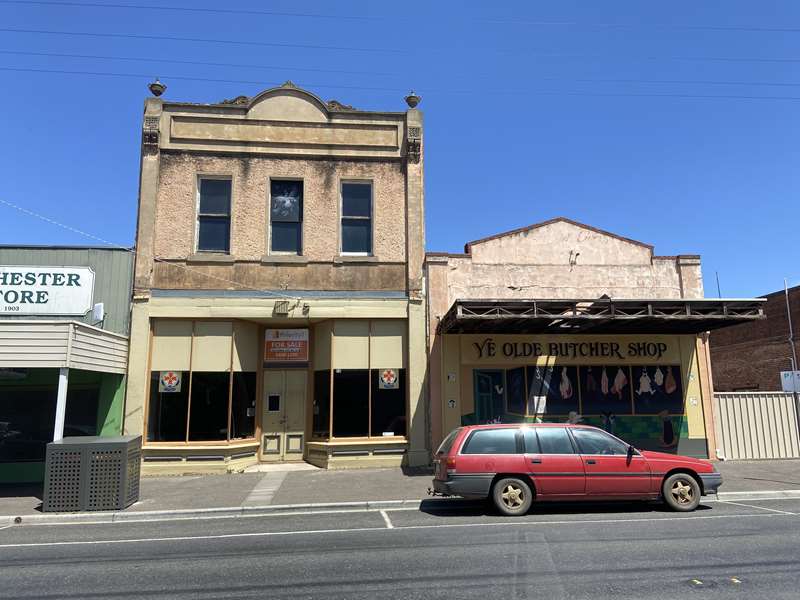
Before the 1862 fire these two sites were occupied by Hardigan (hairdresser) and J. Williams (fruiterer). Upon rebuilding they were then occupied by Archibald Stewart (boot shop) and J. (fruiterer). Since then these shops have been used by various William? businesses including fruiterer, hairdresser, tailor, watchmaker, draper, mechanic, milliner and boot and shoe sales and repairs. From 1913 until 1961 Eric E. Rochester operated a boot and shoe business which was carried on by his sons Eddie and Richard until the business closed in 1983.
9. Joseph Tivey
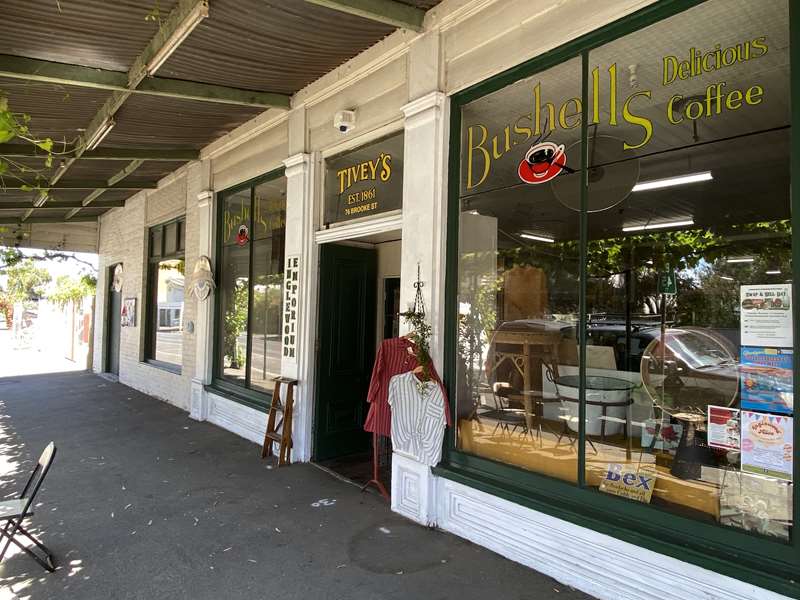
A native of England he came to New South Wales in 1848 and on to Old Inglewood where he had a store on that goldfield in 1860. Joseph Tivey entered into business with William Jennings in Brooke Street on this site in 1861, dissolving the partnership in September 1865. Following his death in 1893 the business was carried on by his sons, Samuel and Joseph. It was then sold to the Ron Nixon family in 1931, trading as Tivey Brothers until 1971, then as 'Nixons' until sold in 1978. It has since been a 'Goodfellows' and 'IGA' supermarket. A giant cellar lies beneath this substantial building.
10. W. Jennings
Demolished in 2024.
11. Bakery
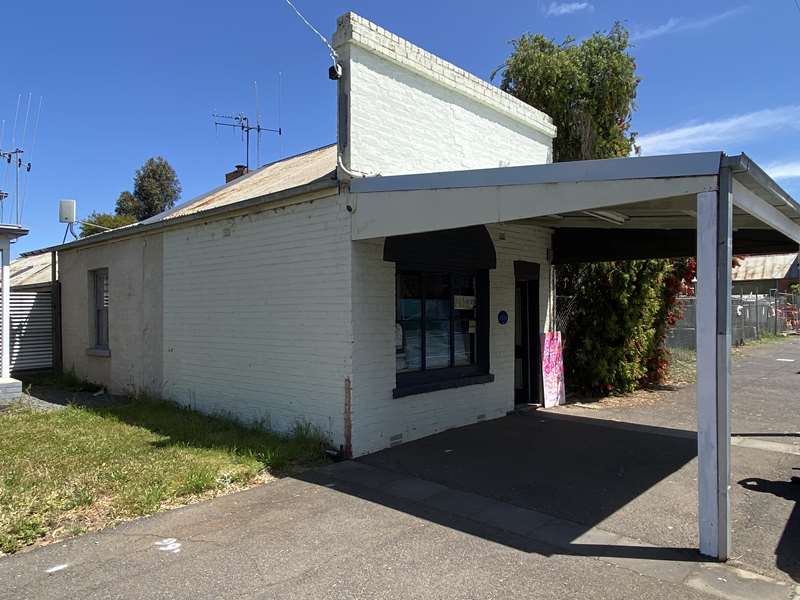
In the late 1880s Emily Jones arranged for a brick bakery to be erected on this site. Directly behind the building and over Storm Lane a bakehouse was built where she made all types of bread and confectionery. In 1900 the bakery was sold to Eddie Lawson. Various bakers have owned the premises over the years and in more recent times it has been occupied by a hairdresser and antique dealer and is now a private residence. This building is a fine example of the many small shops that were found in Brooke Street in the 1800s.
12. Appleby's Garage
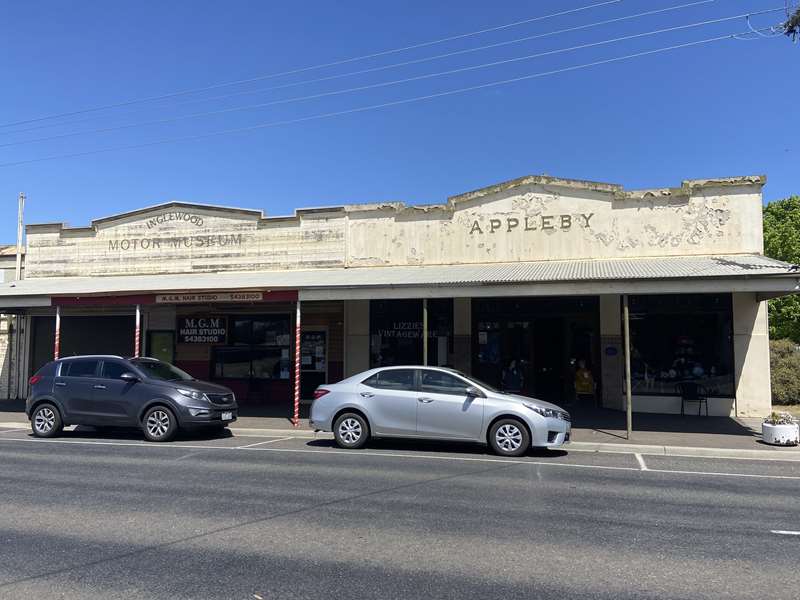
In 1916 Jim Turpie and Alan Gillespie opened a farm implement business, which included the district's first tractors. Soon it was to become a motor car garage with Charles Boyle as the mechanic who later took over the business. In 1927 Fred Appleby bought the premises, extended the workshop and built a car showroom with a residence behind it. The car showroom with its polished wooden floor opened as 'The Dance Palais' in 1931.The family business was sold in 1983 and has since been used as a motor garage, car museum, antique shop and take-away food shop.
13. Masonic Lodge

This Masonic Lodge Temple (Aurora) was built on this site in 1892 at a cost of 600 pounds. The first meeting of the lodge was convened on July 3rd 1861 at the Royal Hotel. After the Great Fire of 1862 a special room was erected within the hotel for lodge meetings and from 1883, meetings were held in the Town Hall. The ornate decoration found in this building is unique in its design. The new lodge building was originally set back from the footpath with garden and palm trees in the front. In both 1932 and 1983 the building was extended to its present form.
14. Empire State Hotel

The Empire State Hotel began business on this site in 1861. The original timber hotel was destroyed by fire in 1872 and the present double-storey building was erected on the same site using bricks that appear to be locally made. The five foot three inch bluestone corner foundation stone from Newbridge was laid on October 30th 1872.The new building opened for business on October 12th 1873. The balcony was added in 1927. This is Inglewood's second oldest surviving hotel.
15. Mechanic's Institute
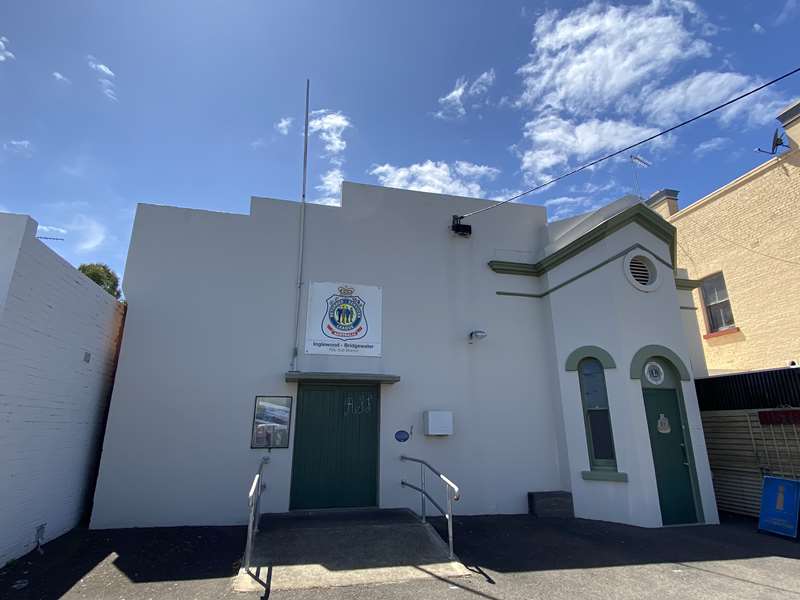
The Mechanics' Institute was built in 1862 as a free library and reading room. By 1885 the room was overcrowded and the adjoining allotment on the south side was purchased with a reading and committee room erected to connect with the original building. In 1953 the R.S.L. took over the building with the front section being enlarged in 1957. From 1971-1980 the Senior Citizens then the Apex Club also used it. Since 2002 the Inglewood Lions Club as well as the R.S.L have used the building.
16. Herbert Lamont - Solicitor
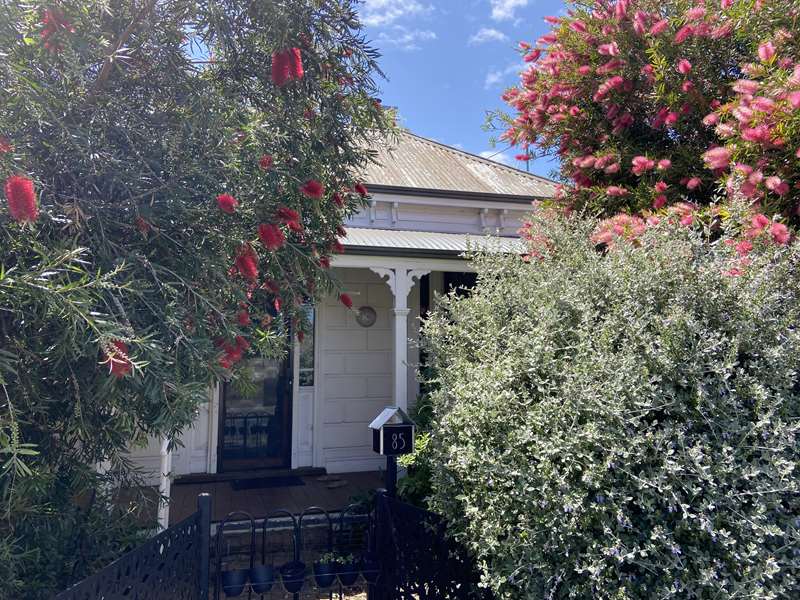
Dr. Henry Radcliffe occupied a house and surgery on this site from 1865. Mr. Herbert Lamont, solicitor and barrister, followed in 1869, operating his business from an office in the house until just before his death in 1908. Later it passed to Horrie Garonne, electrician, followed by local ambulance officers and then the local health services. It has since been used as a private residence. The shop on the south side was built as an electrical store for H. Garonne, then used as the Inglewood TAB and later as a fruit and vegetable shop. Thomas Davies, watchmaker, occupied an earlier shop on the same site from 1865 until about 1905.
17. Pelican Hotel

The hotel was operating on this site prior to November 1860 and featured in the first town survey in 1861. The hotel's original owner, George Piggott, was a prominent local businessman and Borough Councillor. In the 1870s the hotel was the Cobb and Co. Office with extensive stables and yards through to Grant Street. From 1907 to 1917 John Donaldson was the licensee. His son Jack, known as 'The Blue Streak', was a champion sprinter holding world records over several distances. He raced in Australia, New Zealand, South Africa, England and America. He died, aged 47 years, in America in 1933. In 1907 the front part of the hotel was demolished and a more pretentious structure took its place. This hotel was delicensed in 1969.
18. Adelphi Hotel
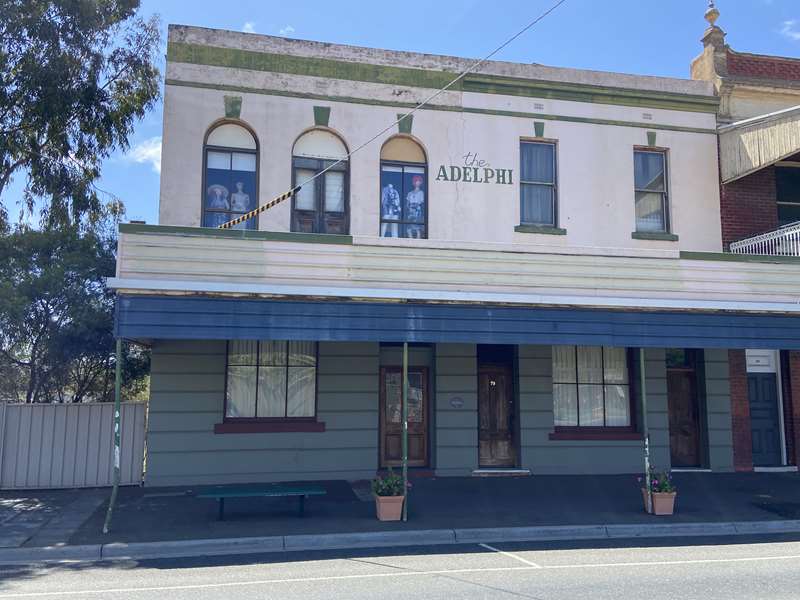
This hotel was built for Mr. John Lawsons prior to 1863. A special Crown Lands purchase agreement dated 4th September 1861 states that he paid 6 pounds 17s. 6d. for the site. The Licenses Reduction Board delicensed the hotel in September 1914. After this it was used as a grocery and gold buyer's store and later as the Ade1phi Cafe and Cash Store. The Seaman brothers operated a greengrocery and a confectionery store from 1941 to 1977. In 2001 it finally closed as a shop and is now privately owned.
19. C.J. Ansett Bicycle Shop & Motor Garage *
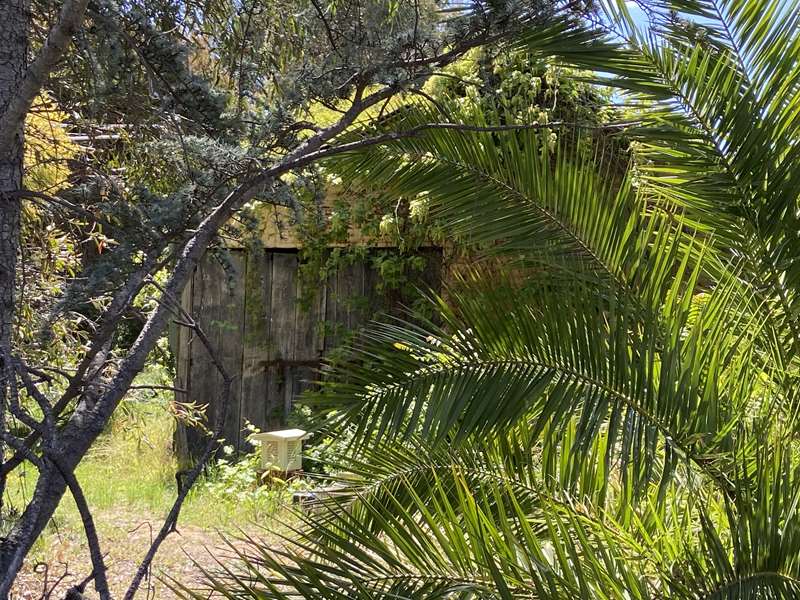
The earliest use of this site was by ironmongers Morrow and Donovan in the 1960s. From c1900, the firm of Ansett and Ogden, bicycle manufacturers, produced "Avon" brand cycles here. With the advent of the motor car, the Ansett business switched to service as a motor garage.
Charles Ansett, while Mayor of the Borough, enlisted and served in the First World War. He sold the business to Roy Innes and moved his family to Melbourne. One of Charles' sons, Reginald, born in 1909, later went on to establish Ansett Airlines. Some other owners of the garage business have been Lewis Hill, J.R. Johnson, J.M. Devereux, Scotty Hutcheson and Wally Hull. The garage finally closed in the 1950s, but the rear section of the long building remains as a reminder of-the Ansett family's time in Inglewood.
20. State Savings Bank
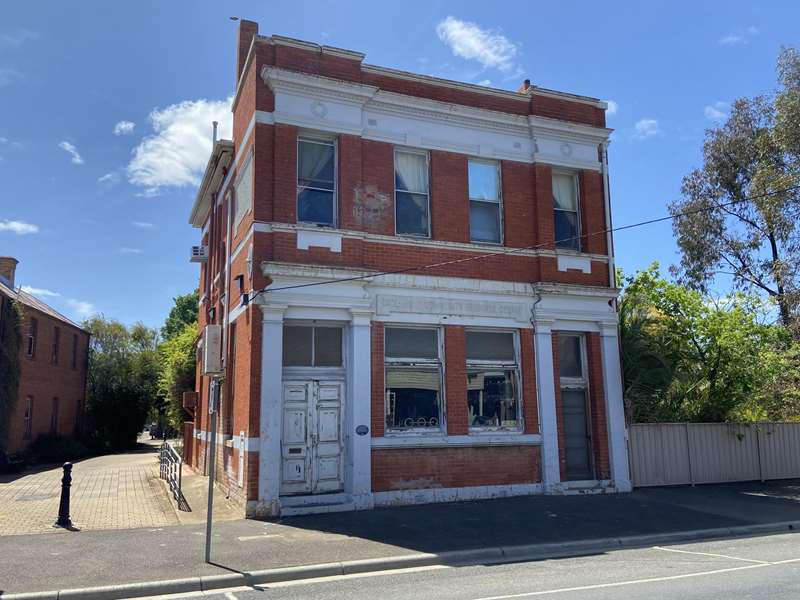
The bank was built on the site of the Bobby Burns Hotel whose license was surrendered in April 1908. In 1913 the old hotel was purchased by the State Savings Bank of Victoria and demolished to make way for this new building. George Pallet and Son, contractors of Richmond, built the bank and the Borough Mayor, Charles Ansett, father of Sir Reginald Ansett, officially opened it on 29th May 1914. The bank closed its Inglewood branch in August 1993. From 2001 to 2006 it was home to the Inglewood Community Resource Centre.
21. Royal Hotel
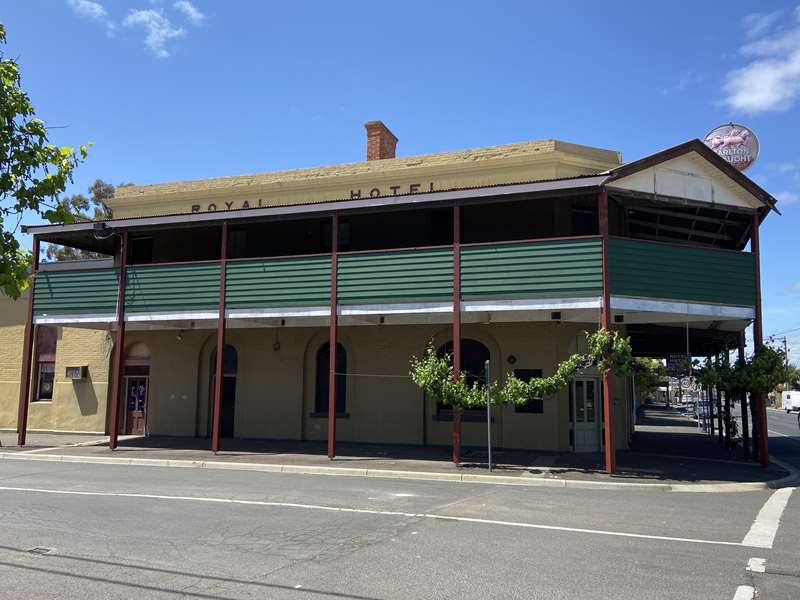
The Royal Hotel was built by the original grantee, Thomas Tatchell, with weatherboard facade, calico walls and iron roof, opening in March,1860. A more permanent weatherboard structure was destroyed by the Great Fire of 1862. Next a brick building, designed by architects Vahland and Getzschmann of Sandhurst, was opened in 1863 with Masonic Lodge room and bowling alley. A single verandah was added in 1866, further extensions in 1876 and a balcony in 1937. One of Cobb and Co's booking offices, it featured a beautiful lead-light lamp under the hotel verandah which now hangs in the Town Hall. The oldest surviving hotel in Inglewood, it is a lasting reminder of the goldrush days, complete with 100 year-old plus grapevine.
22. Chancery Lane
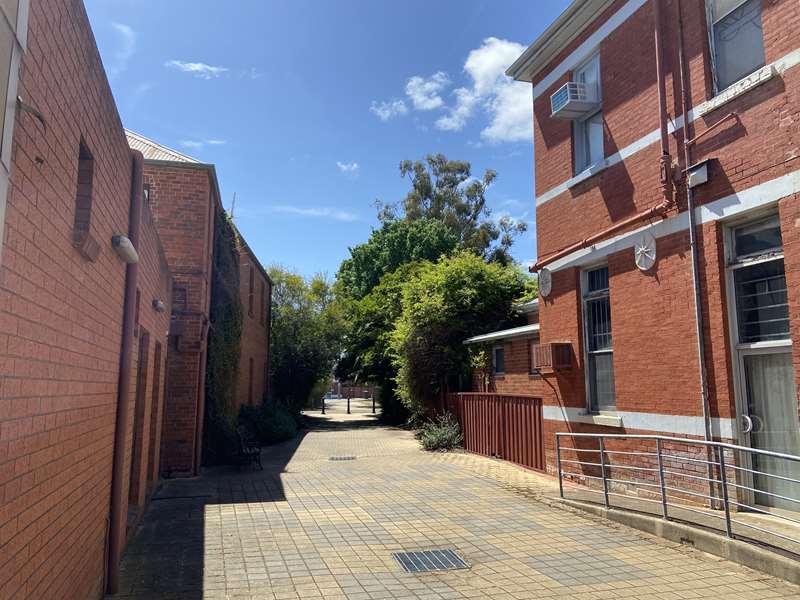
A photograph (c1860-2) of Chancery Lane looking from Brooke Street towards the Post and Telegraph Office in Grant Street shows a line of narrow-fronted shops on both sides which included the Inglewood Advertiser newspaper office and the Courthouse Hotel. In all, a very busy area on the way to the Police Camp, the Survey Office and the Magistrate's Court. Following the Great Fire of 2 December 1862 most of these Chancery Lane businesses relocated to Brooke Street.
23. Police Camp
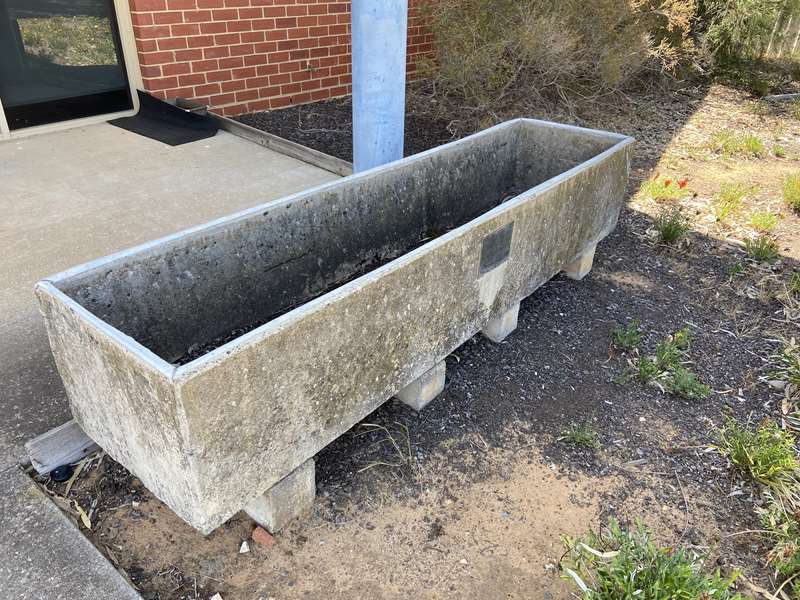
Police presence on this site (New Inglewood) commenced in 1860 with six police officers. A permanent camp was established here in 1861 consisting of several tents, a bark but and later, a brick lock-up. The staff grew to twelve constables and one detective under the leadership of Sergeant Acton. Stables were built in the 1870s and in 1881 a four-roomed wood and iron residence replaced the original 1861 quarters.
Around 1900 the police offices were transferred to the south end of the Post Office continuing there until 1967, when a three-roomed portable police station arrived and a new residence was built. A new purpose-built complex was opened on July 9th 2004.
24. Lock - Up
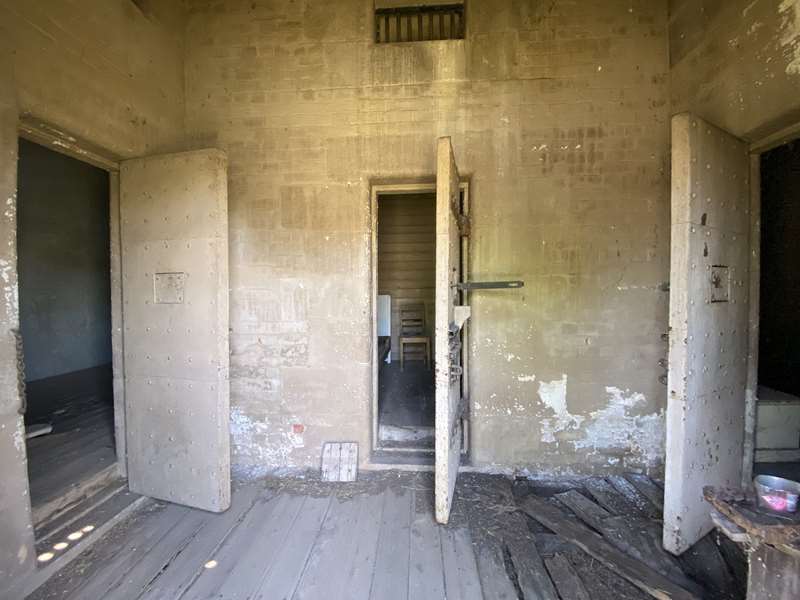
An 1861 map of the Camp Reserve shows that prisoners were kept in two separate buildings on this same site. In 1869 Edwards Brothers constructed a new brick building at a cost of 623 pounds. It consisted of three large individual cells and was handed over to Sergeant Acton on February 5th 1870. Twelve constables and one detective were under the sergeant's command. This lock-up was last used in 1964.
25. Post Office
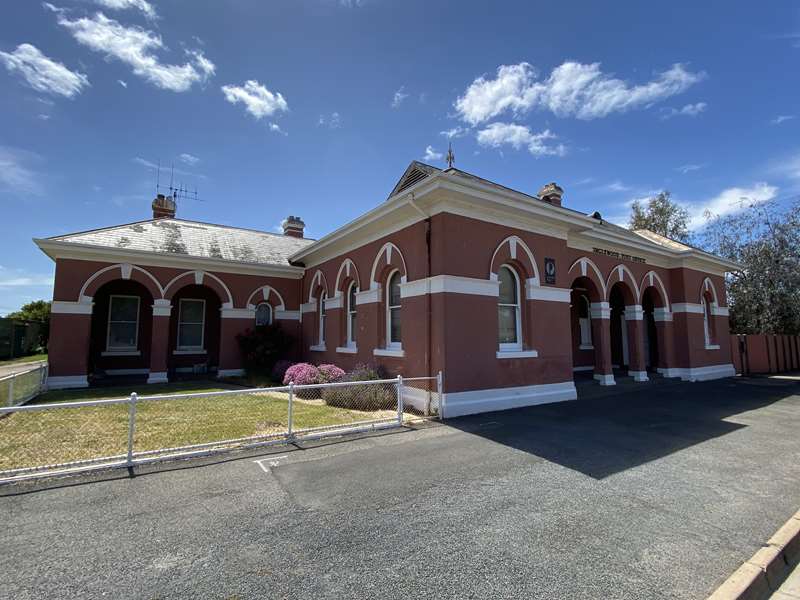
The first Post Office on this site was opened in Inglewood on 14th May 1860. With the coming of the telegraph line to Inglewood in 1862 the Post Office also served as a Telegraph Office. In 1883 the present Post and Telegraph Office was built in brick to a Public Works Department design at a cost of 1049 pounds. Part of the building, which was used as the Receipt and Pay Office, was later to house the Police Station and afterwards the Department of Crown Lands and Survey. The Post Office and the Lock-Up are the last two Government buildings on the Police Camp Reserve.
26. Fire Station
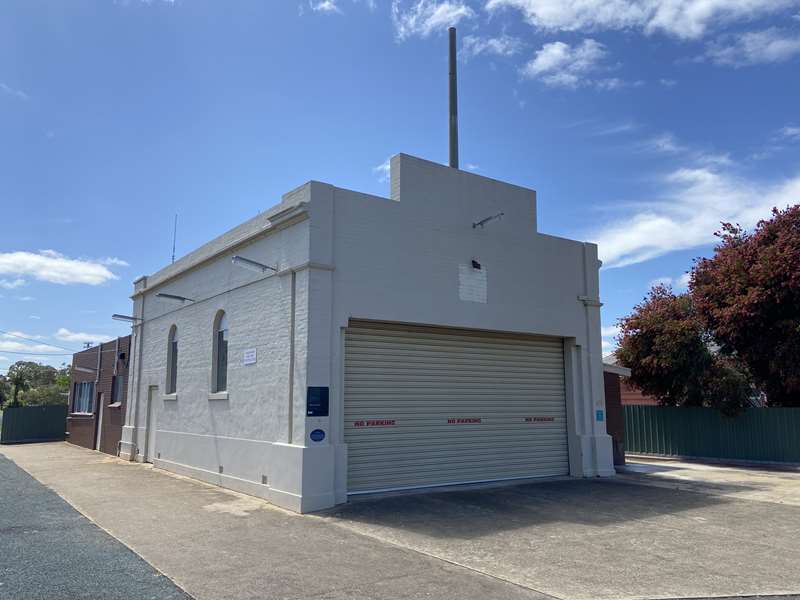
At the time of the Great Inglewood Fire of 1862 there was no town fire brigade, the only way to combat fire was by means of a 'bucket brigade'. A meeting to form the Inglewood Volunteer Fire Brigade was held on June 2nd 1864 when apparatus was purchased. Tenders were called in May 1866 to build an engine house on this site. The building featured a large arched doorway with a triangular pediment surmounted by a bell tower. The facade was altered to accommodate motor vehicles but the rest of the building remains unaltered.
27. Dr. Bill Brennan's
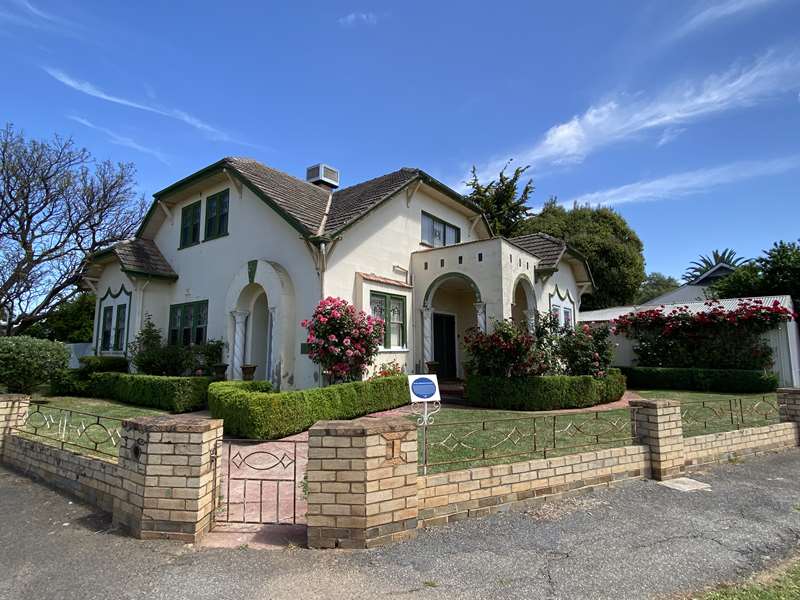
From the 1880s this was the site of Morgan and Miller's blacksmith's shop. The old timber and corrugated iron building stood idle for many years before demolition in the 1920s. This house was built for Dr. Bill Brennan as a private residence and dental surgery, opening for business in 1934. Its Spanish Mission architectural features (inspired by the Spanish mission churches of colonial America) include unusual rooflines, attic and an arched portico corner entrance with twisted columns. The building is constructed of wooden lathes covered with smooth stucco. It is now occupied as a private residence.
28. Craignish

Thomas Bradburne, produce merchant, lived on this site from the early 1860s and later, police magistrate William Wentworth Green lived here. During the First World War the building, then known as 'ALLOA' was used as a private hospital. John Rollinson, a local grazier and his family occupied the house from 1920 to 1955 when ownership changed to the McNish family. Some years ago the house name was changed to 'CRAIGNISH'.
29. Wesleyan Church
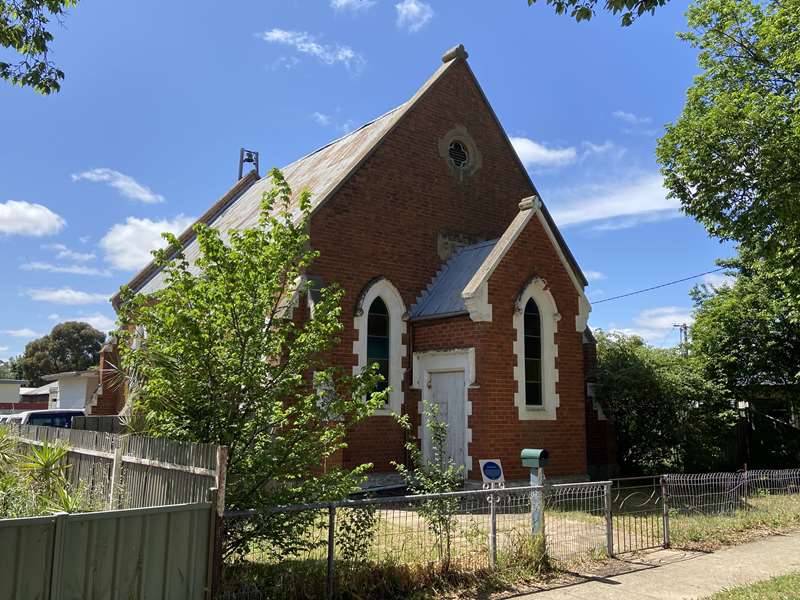
The Wesleyans (Methodist) opened their first chapel in New Inglewood on April 8th 1860 on the east side of Grant Street. In 1876 tenders were called to replace the old corrugated iron building. The current brick church in Gothic style was built by Messrs. Johns Brothers in front of the old galvanised iron church. The foundation stone was laid on September 9th 1876. Above the porch the words 'Wesleyan Church' are still partly visible. The Methodist Church became the Uniting Church in 1977.
30. State School
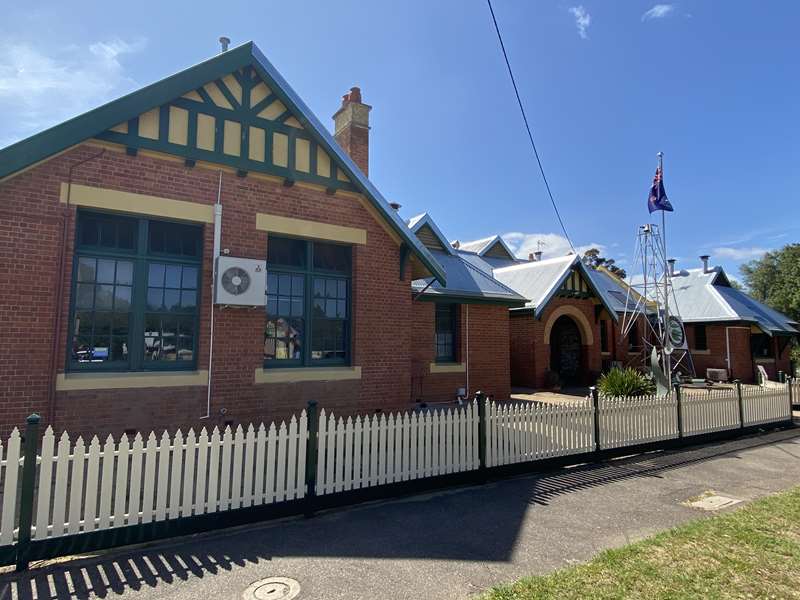
31. Railway Hotel
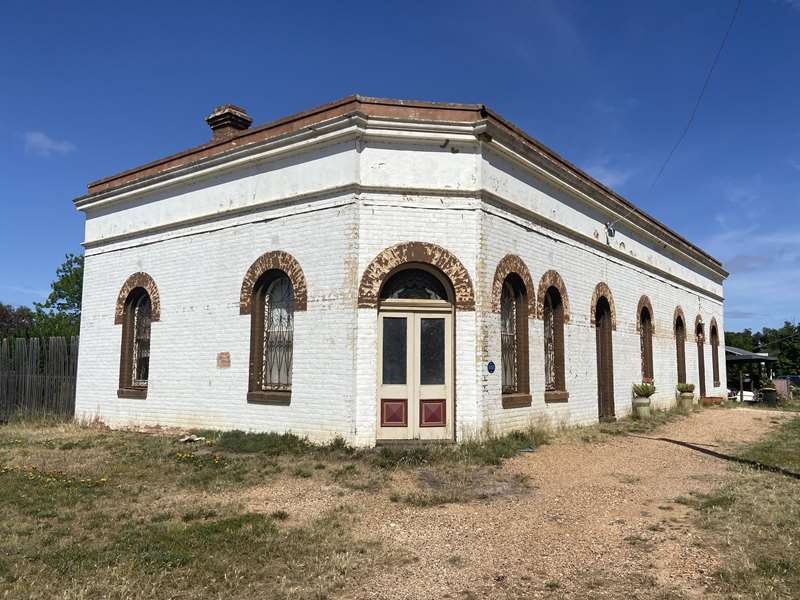
We believe the first licensee of this hotel was Alice Watts in 1879 followed by Moses Toghill in 1881. The hotel was built after the railway line came to Inglewood in 1876. Known for some time as 'The Weighbridge Hotel' the name changed to 'Railway Hotel' about 1885. With the railway station nearby the hotel was in a prime position to gain patronage from train passengers as well as locals. The hotel was delicensed in 1963 and is now a private residence. The building remains the same as in the past except that the verandah has been removed.
32. Court House
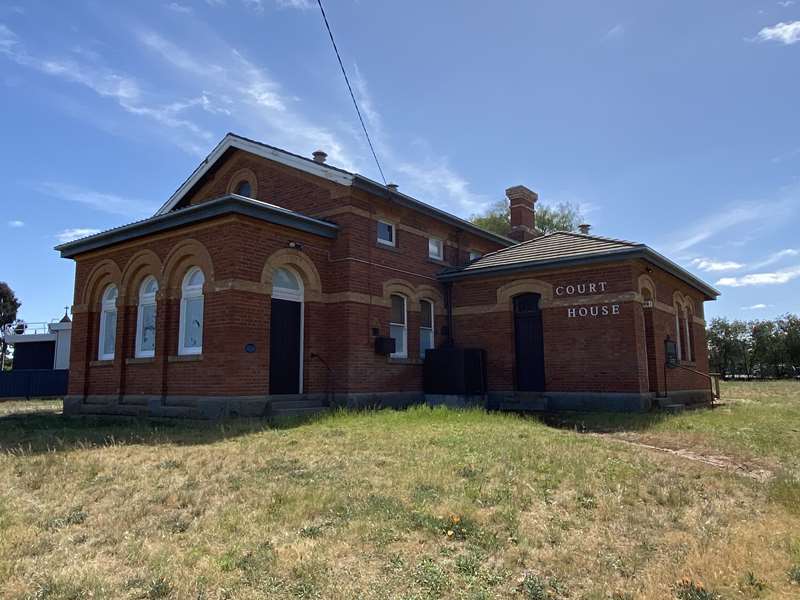
The building of the Court House commenced in 1866 to a standard Public Works design on what was then known as Hospital Hill. The first court case was heard on May 12th 1869. Regular sittings at the Court House accommodated the Court of Petty Sessions, the Mining Warden's Court and County Court. The Court House was finally closed in 1983 and since then has been used by the Inglewood District Historical Society. The Court House building remains intact along with its original furniture and, in 1990, was listed on the Victorian Heritage Register.
33. Inglewood Railway Station
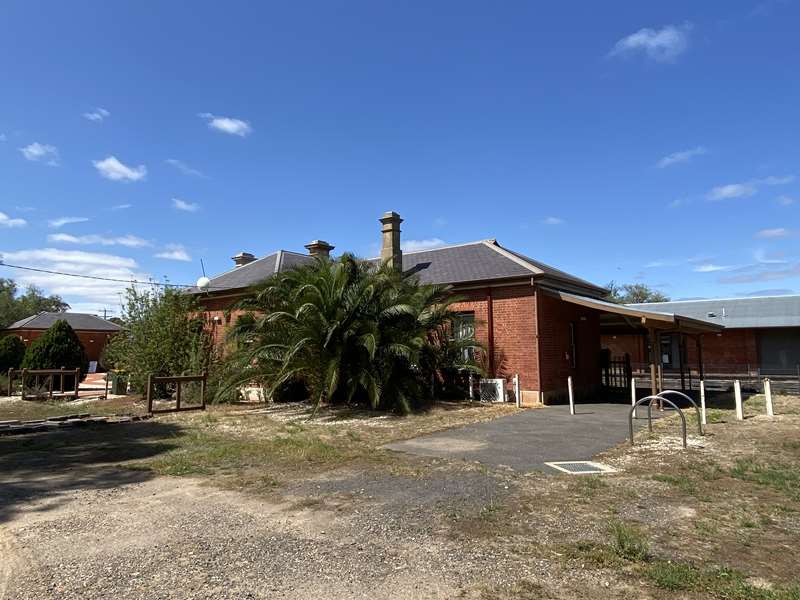
The Sandhurst to Inglewood Railway was opened on November 17th 1876 by His Excellency, The Governor, Sir G.F. Bowen at a ceremony in a marquee in Verdon Street. The line from Sandhurst was built by Thomas Doran, taking twenty months to complete. Mr. Isaac Summerland built the station buildings. The overhead walkway above the tracks was opened in July 1888. The walkway and turntable were removed some years ago. The passenger train service ceased in the 1980s with only freight trains using the lines now.
34. Hospital

The first building in 1863 is reported to have been a six-room cottage constructed of iron and timber having two wards, one male and one female, a tiny dispensary, matron's room, kitchen and a servant's bedroom. A new brick, double storey hospital was built later that year with two new wings added in 1874. It was reduced to a single storey building in 1937 along with other major renovations. Nursing home accommodation was added in 1972. 1n 1994 a modern twenty-bed hostel was added and in 1998 further works saw the administration and entrance area undergo extensive renovations. In 2001 the nursing home was rebuilt with the acute wards and emergency area renovated.
35. St. Mary's Roman Catholic Church
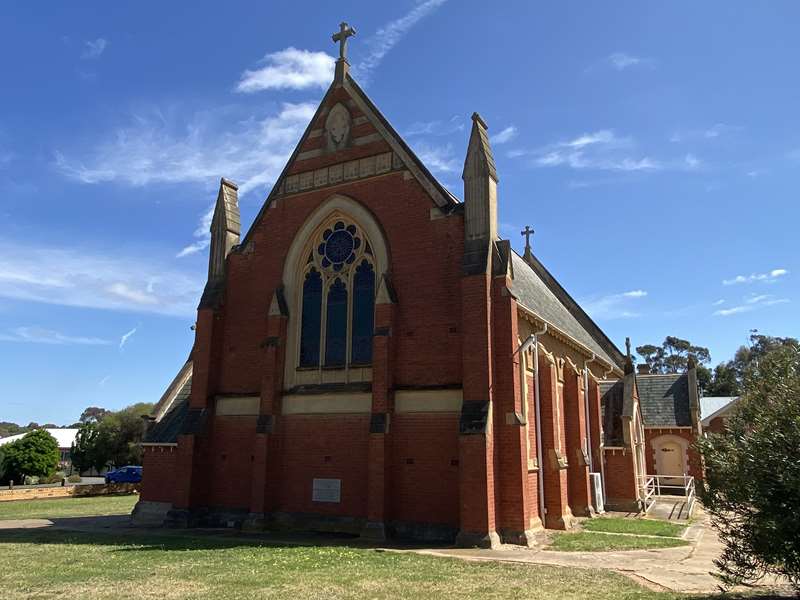
The Very Reverend Dean Hayes of Sandhurst opened the first church on this site, a timber structure serving as a church and a school on November 8th 1866. The present red brick church was built in 1905 and the opening ceremony and blessing held on December 17th 1905 by the most Reverend Dr. Reville, Bishop of Sandhurst. Messrs. Keogh and Austin, architects of Bendigo, designed the church, the building contractor being Mr. Luff. The total cost of the church was in the order of 2770 pounds.
36. St. Mary's State School
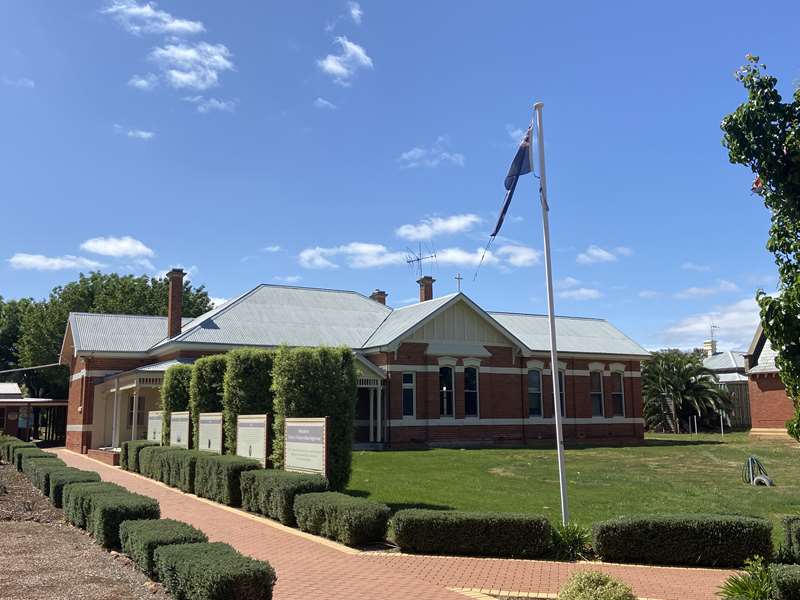
A weatherboard structure serving both as a church and school opened on November 8th 1866 on this site. In 1907 a new school was built in red brick, the architects being Messrs. Keogh and Austin and the builder, Mr. Johns of Bendigo. The blessing and opening of the new Sacred Heart Presentation Convent took place on September 22nd 1907.The nuns came from the 'Star of the Sea' Convent in Elsternwick and left Inglewood in 1974 after 67 years of teaching service at the school. Nowadays teachers are employed through the Catholic School system.
37. St. Augustine's Church

The present church was designed by architects Vahland and Getzschmann and built of local brick by Mr. Rose. The foundation stone was laid on February 2nd 1864 and the church opened for services on June 16th 1864. In 1878 a Fincham Pipe Organ was acquired and in 1884 extensions took place with the erection of a sanctuary, vestry and organ recess. The organ was placed on the Heritage Victoria Register in 1990. St. Augustine's Church was classified by the National Trust in 1973 and remains one of the oldest and finest buildings in Inglewood. Many of the beautiful stained glass windows are endowed as memorials to local benefactors.
38. Church of England Sunday School Hall (Anglican Parish Hall)
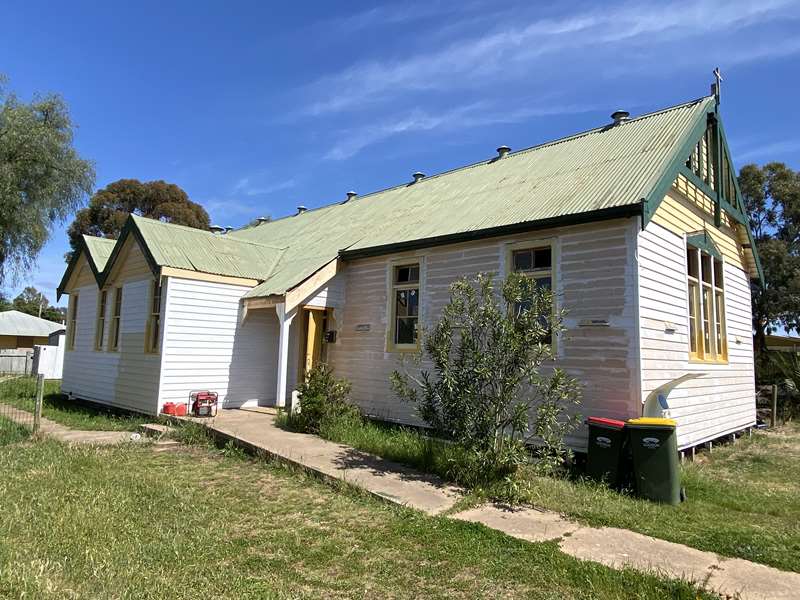
Prior to the erection of the St Augustine's Sunday School Hall in 1894 a small timber and iron cottage owned by a local butcher occupied this site. Messrs. Laver, Fick and Vance of Melbourne were the architects and Messrs. Brewer and Libou the contractors. The hall opened on October 23rd 1894 and classes were held twice every Sunday due to the large number of children. In recent years this hall has been used for dancing, the annual Pancake Day, afternoon teas and other community events.
39. Congregational Church
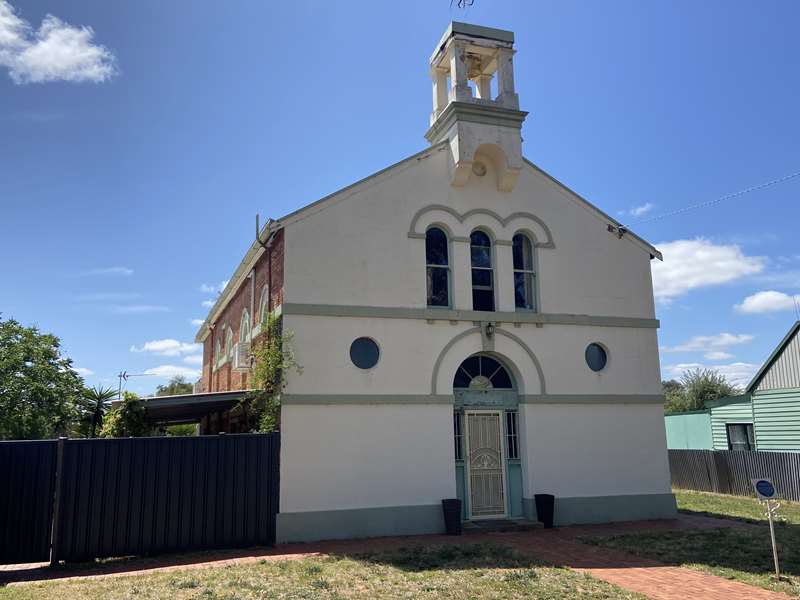
Shortly after the Great Fire of 1862 enthusiastic minister, Rev. Alfred Brunton, organised the building of a church on this site with the foundation stone laid on 3rd February 1863. Built by Joseph Harrison this was the first permanent church in Inglewood. It features unusual front windows and an ornate bell-tower supported by four stone columns at the highest point of the gabled roof. Soon after the departure of Rev. Brunton the church was sold to the Presbyterians, remaining with them until 1977 when the Uniting Church was formed. It is now a private residence.
40. Thomas Morrow
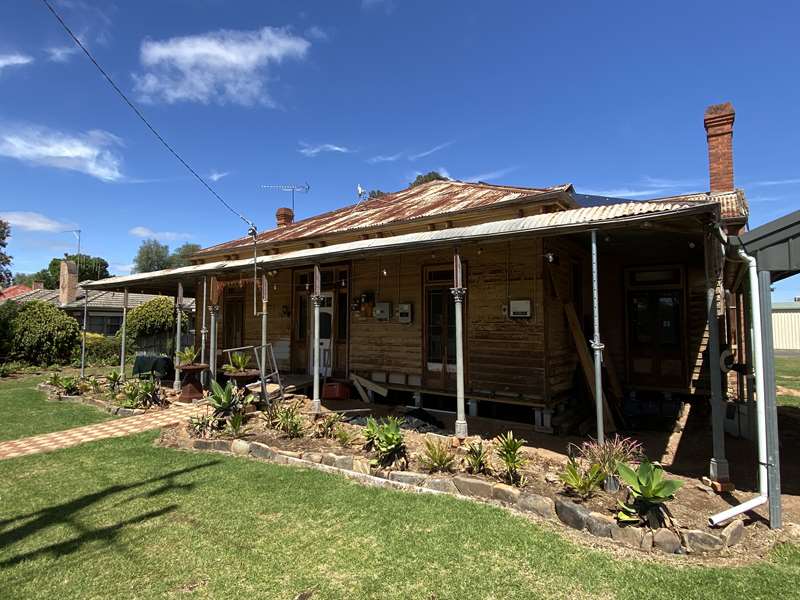
Thomas Morrow started an ironmongery and timber business in Inglewood in partnership with Richard O'Donovan in 1860. He was a member of the Inglewood Borough Council for twenty years and mayor on three occasions. His house, built in 1892, was known as 'The Bungalow' and consisted of four main rooms and a detached kitchen. An unusual feature of the house are the two wells and pump underneath, the 'L' shaped dancing and entertaining room, the different sized doors and windows and the intricate cast iron lace-work. Thomas Morrow died in 1911, his family remaining in the house until the late 1920s.
41. Ford's Hotel
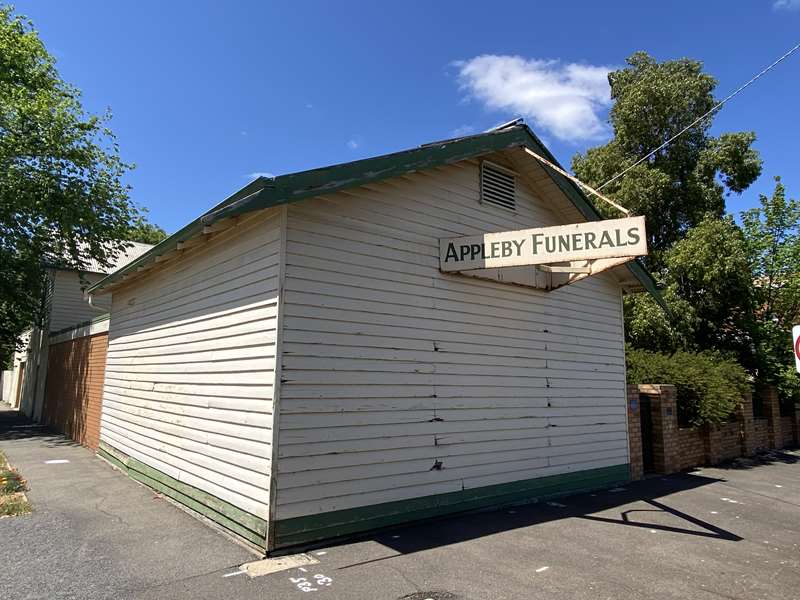
This was the early site of Ford's Hotel, also known as "The Cricketers' Rendezvous" which operated from the very early 1860s. The hotel operated until the late 1880s with George Ford the early licensee. Mr. Ern Wilsmore, undertaker, purchased and demolished the old building in 1916. The billiard room of the delicensed Harp Of Erin Hotel was shifted here to become the mortuary and workshop. The Appleby family owned the business from 1937 to 1970. William Farmer, Funeral Director, of Bendigo, now owns it.
42. Charlie Napier Hotel
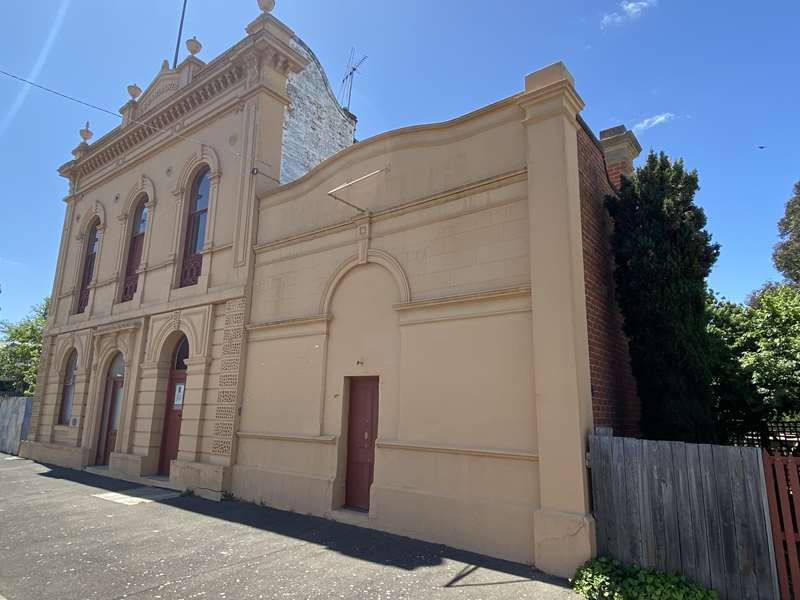
The first Charlie Napier Hotel was built in 1860 by John Sorg. Following windstorm damage in 1862 it was rebuilt again in timber. In 1874 Frederick Klein and Elizabeth Sorg demolished the old building and replaced it with a single storey brick structure. The second storey was added in 1879 and a billiard room in 1909. In 1906 a painter who signed himself 'Len Moodie' completed a series of wall murals in the bar room. The hotel was delicensed in 1967 and sometime after this the beautiful balcony and lacework verandah removed. In 1995 Heritage Victoria listed the building.
43. Wyreema
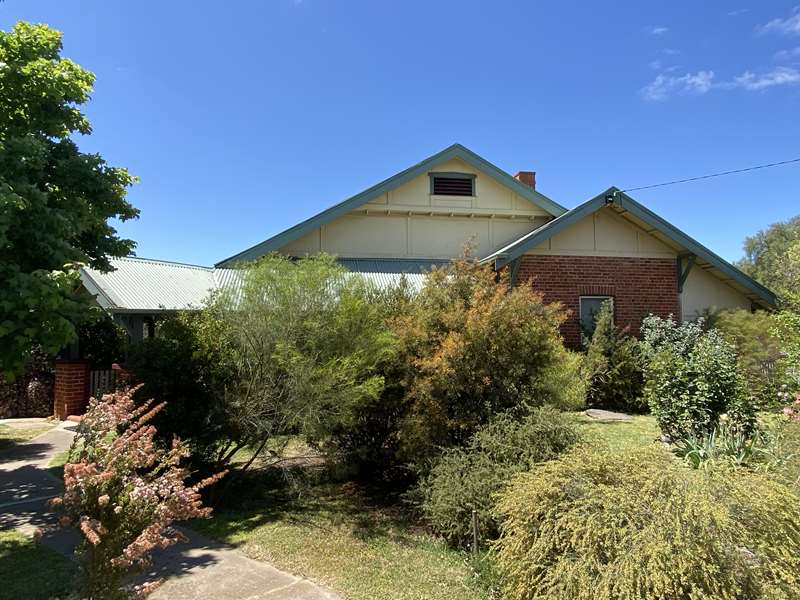
This house was built on the site of Inglewood's first licensed hotel, the Forget-Me-Not. The hotel was pulled down during the 1862 fire and rebuilt the following year. After the hotel was delicensed it was used for many years as a boarding house. It was demolished in 1910 and the site remained vacant until about 1922-23 when this uniquely styled house was built.
44. Nixon's Store

George Nixon established his first store in a tent on the Old Inglewood goldfield in late 1859.The brick shop that he built on this site prevented the Great Fire of 1862 from progressing further north along Brooke Street. In the late 1860s George Nixon built the Exchange Hotel on the south end of his store, rebuilding it again in 1889. The hotel was delicensed in 1914 and his grandsons moved the grocery business back to the hotel area. The original shop on the north side was demolished in 1960. Roy Nixon sold the business in 1964 after 104 years of family ownership.
45. Bank of Victoria
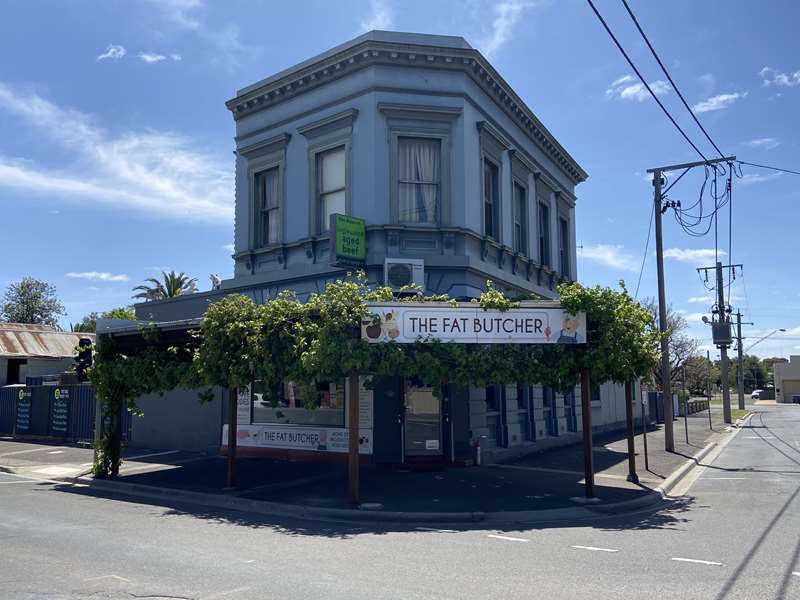
At the time of the Great Fire of 1862 Roff, a fruiterer, occupied this site. Once rebuilt it became premises of J. M. Pratt, Auctioneer, then Thomas Phillip's Chemist shop until demolition in 1876. Messrs Nation and Co. of Melbourne erected the present double storey building for the Bank of Victoria, which opened in Novembe 1876. The Bank was amalgamated with the Commercial Banking Company of Sydney and was known by this name from 1928 until it closed in 1943. Since then this building has been a butcher's shop.
46. Freeman's Bank
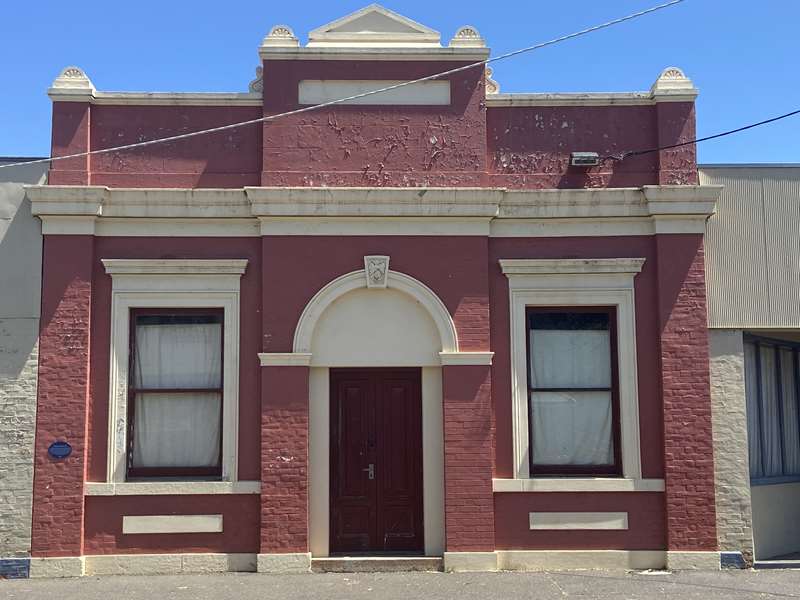
A timber and iron building, the London Chartered Bank of Australia (Australasia) stood here until it was destroyed in the Great Fire of 1862. It was rebuilt in brick and continued in this name until 1869 when it became the Bank Of Victoria. In 1876 it closed as a bank to reopen as 'Freeman's Bank Hotel' with billiard rooms attached. It was delicensed in September 1914. Around 1953 Mr. Syd Stagg purchased the building. It was converted to 'Staggs Garage' and motor vehicles were serviced here until 1996. The front of the building has since been restored to its original design.
47. Blue Eucy Cafe
48. Advertiser Office
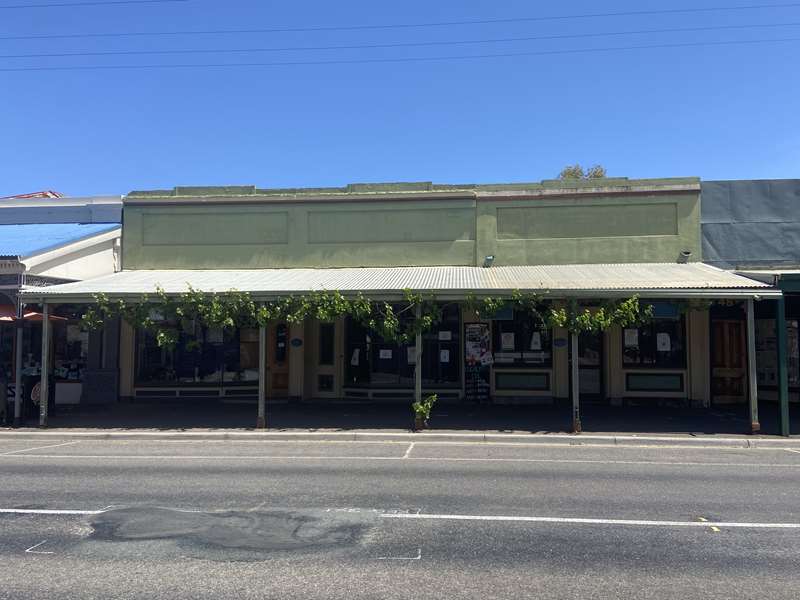
The publishing of the Inglewood Advertiser commenced in Chancery Lane early in 1860 under the proprietorship of Mr. Gearing and Mr. Nutall. Later in 1860 it was owned by Julius Vogel who was later to become Sir Julius Vogel, the Premier of New Zealand. After being destroyed by fire in 1862 the timber and iron office building was rebuilt next to this site in Brooke Street and built again in brick in 1883. Three issues per week were printed in those days. In 1963 the Inglewood Advertiser office closed when the paper was amalgamated with the Wedderburn Express to become 'The Wedderburn and Inglewood Express'. From 1964 until 1993 the building was used as a drapery and craft shop.
49. Cyril Medlin's Drapery
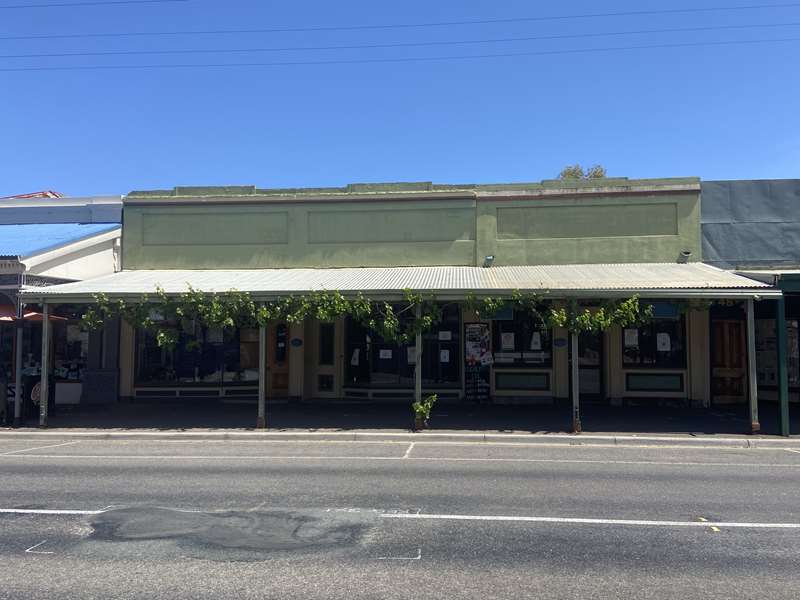
The Great Fire of Inglewood reputedly started here, in Herley the Draper's shop, on December 3rd 1862. The shop was rebuilt in timber and in 1883 in brick. The two shops have been in use by: auctioneer, dealer, solicitor, baker, tailor, hairdresser, pastrycook, watchmaker, tobacconist and draper. Cyril Medlin took over the drapery from 1940 until 1965 when Arthur Treble purchased the business continuing until 1993. In recent times a hairdresser has occupied these premises.
50. Chemist
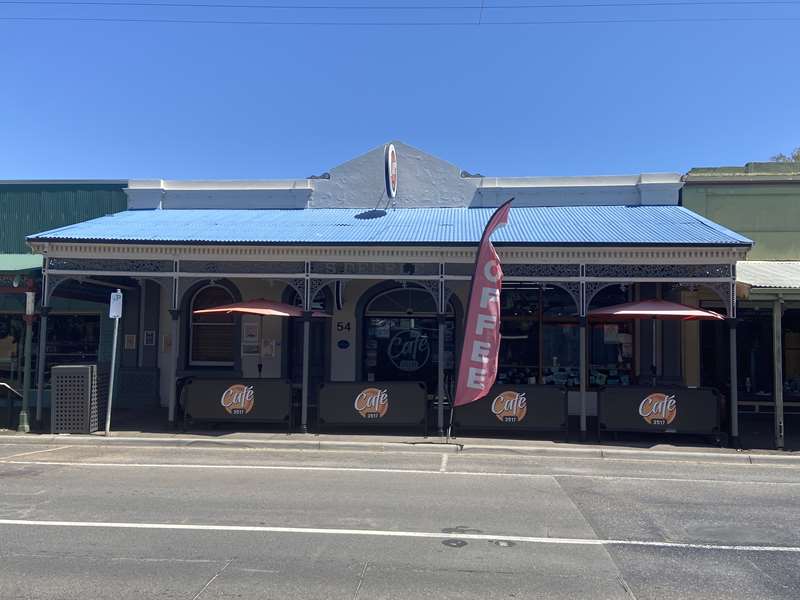
This site was possibly home to an early hotel and is adjacent to where the Great Fire of Inglewood began on December 3rd 1862. Sixty-five shops and buildings were destroyed, most of them uninsured. After the shop was rebuilt Thomas Morrow and Co., auctioneer, occupied the site followed by Samuel Deeble, auctioneer, whose name can still be seen on the front iron lacework. In 1924 Mr. Arthur Jones shifted his chemist shop from next door to this site where he continued his business until 1986, serving for sixty-two years as Inglewood's chemist.
51. Central Cafe
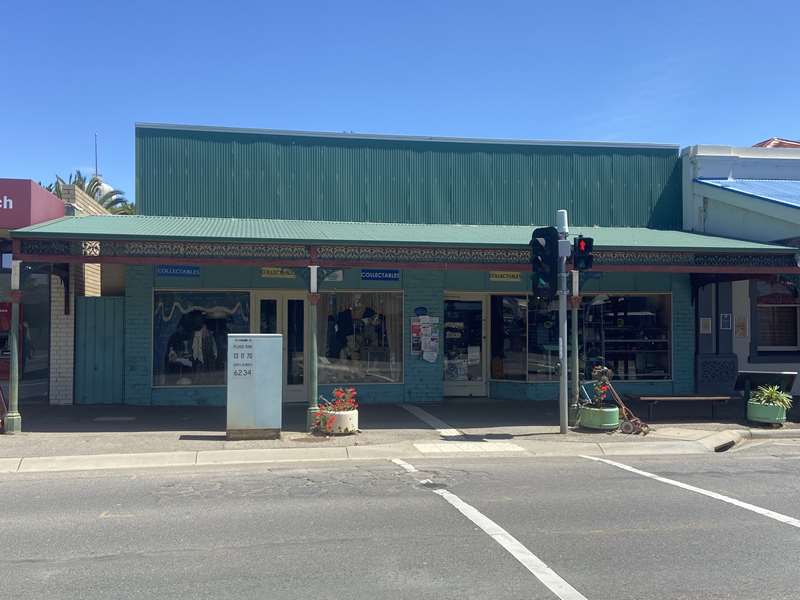
Mr. Tillett, a chemist, occupied this site until it was destroyed in the Great Fire in 1862.The shop and dwelling behind was rebuilt in brick by Rankin and Moore who had built the Bank Of New South Wales some time before. The building was re-opened in 1863 by Tillett, followed by another chemist, Thomas Phillips. The building was divided into two separate shops for most of its life. It has been used by: druggist, doctor, draper, chemist, bakery, confectionery, cafe and C.Y.S.S. Centre and was for many years unoccupied. The facade and verandah were renovated in 2005.
52. Bank of New South Wales
This is the site of the former Bank Of New South Wales, which built in 1861. The bank was a handsome two-storey building complete with balcony and lacework verandah and manager's residence upstairs. The building was saved in the Great Fire of 1862. It was demolished in 1969 to make way for the present building, which opened in 1970 with a separate manager's residence in Sullivan Street. In August 1995 the Bank Of New South Wales (Westpac) closed their Inglewood branch and I.0.0.F. opened as a bank in October 1995. The Bendigo Bank took over in 1999 and has continued operating since then. In 2007 the status changed to a community bank.
Photos:
Location
Brooke Street, Inglewood 3517 View Map
Web Links
→ Inglewood Historic Township Walk Map (PDF)








